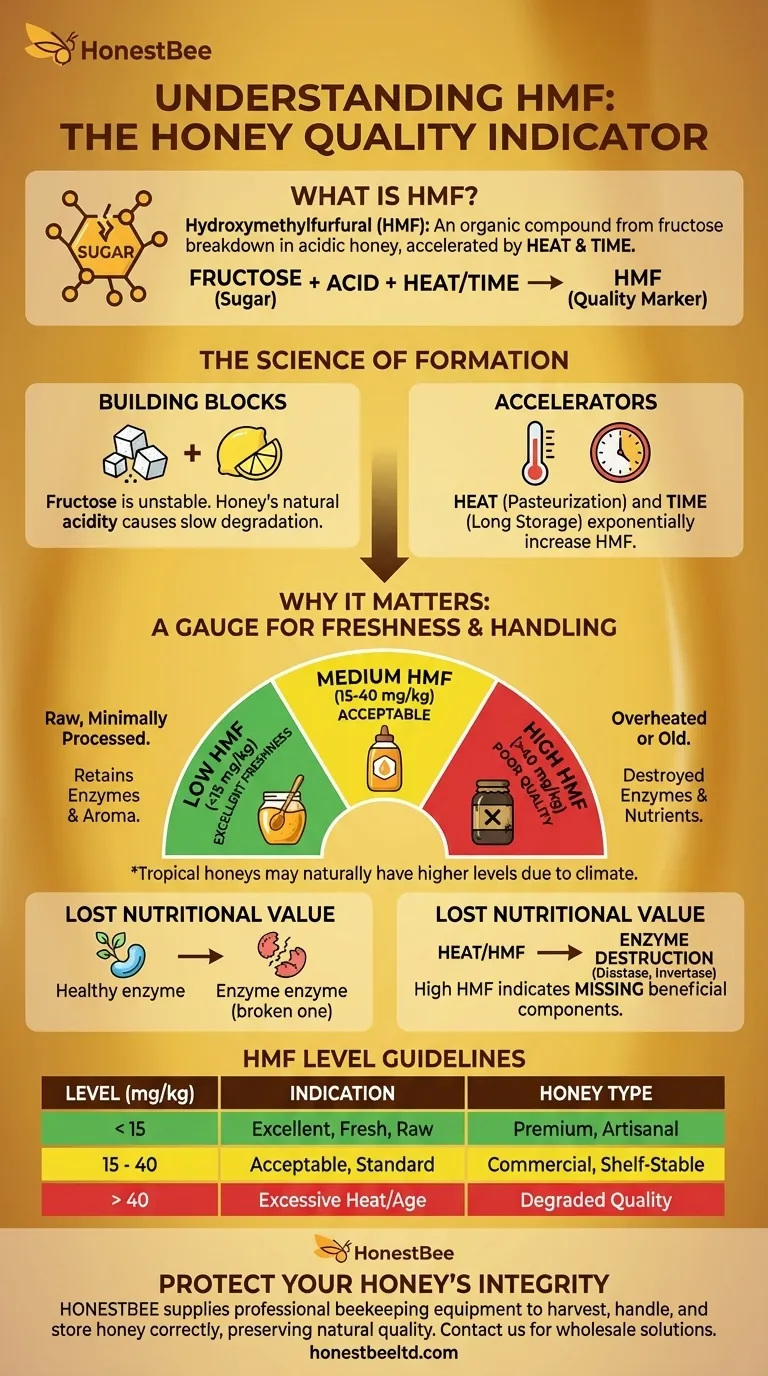In the world of honey quality, few metrics are as telling as hydroxymethylfurfural (HMF). HMF is an organic compound that forms when simple sugars, particularly fructose, break down in the presence of acid—a process accelerated by heat. Its concentration in honey is a critical indicator because it reveals the honey's history, telling you whether it has been overheated during processing or is simply old, both of which degrade its natural quality.
While often discussed in the context of safety, the primary value of HMF is as a freshness and quality marker. Low HMF levels signal raw, fresh, and carefully handled honey, whereas high levels indicate excessive heat exposure or long-term storage, which destroys the beneficial enzymes and delicate aromas that define a premium product.

The Science of HMF Formation
The Building Blocks: Sugars and Acid
Honey is a supersaturated solution of sugars, primarily fructose and glucose, in a naturally acidic environment. This combination of fructose and acid is the perfect recipe for HMF formation.
Fructose is an inherently less stable sugar than glucose. Over time, even at room temperature, the acidic nature of honey will slowly cause fructose to degrade, creating HMF as a byproduct.
The Accelerator: Heat and Time
This natural degradation process is extremely slow in fresh, properly stored honey. However, heat acts as a powerful accelerator.
When honey is heated, as is common in large-scale commercial processing (pasteurization) to kill yeast and slow crystallization, the rate of HMF formation increases exponentially. Therefore, HMF levels are a direct proxy for the heat treatment a honey has endured.
Similarly, the longer honey is stored, the more time the fructose has to break down. A jar of honey stored for years, even in a cool pantry, will have significantly higher HMF levels than a fresh jar.
Why HMF Levels Are a Critical Quality Indicator
A Gauge for Freshness and Handling
At its core, HMF is a "freshness gauge." Freshly extracted raw honey contains virtually no HMF (typically under 1-5 mg/kg). High levels are a clear sign that the honey is either old or has been subjected to high temperatures.
This allows analysts to distinguish minimally-processed, "living" honey from highly-processed, "shelf-stable" commercial honey that has lost many of its natural characteristics.
An Indicator of Lost Nutritional Value
The same heat that creates HMF also destroys honey's delicate and beneficial components. Key enzymes like diastase and invertase, which aid in digestion and are markers of raw honey, are heat-sensitive.
Therefore, high HMF doesn't just tell you what is in the honey; it tells you what is missing. The beneficial enzymatic activity has likely been destroyed.
The Health and Safety Question
While lab studies have linked very high doses of pure HMF to potential negative health effects, the concentrations found in honey are generally far below levels considered harmful. The main concern for honey consumers is not direct toxicity from HMF.
The true issue is that high HMF is a stand-in for poor quality—a signal that the product has been stripped of the very properties that make honey a valuable functional food.
Understanding the Trade-offs and Nuances
Regulatory Standards Are a Floor, Not a Ceiling
International standards, like those from the Codex Alimentarius, set a maximum limit for HMF, typically at 40 mg/kg for most honeys. This standard is designed to ensure basic safety and to prevent overtly fraudulent or damaged products from reaching the market.
However, this is a baseline. Artisanal producers and purveyors of high-quality honey often aim for levels below 15 mg/kg to prove their product is truly raw and fresh.
The Tropical Honey Exception
It is critical to note that honeys produced in tropical climates can naturally have higher HMF levels, even when fresh. The high ambient temperatures of these regions can raise HMF to 20-30 mg/kg or more without any artificial heating.
This is not a sign of poor quality but rather a reflection of the honey's environment. For this reason, regulatory standards are sometimes adjusted for honey from these regions.
Making the Right Choice for Your Goal
Interpreting HMF content allows you to select a honey that aligns with your priorities.
- If your primary focus is maximum nutritional benefit: Seek out raw, local honey and specifically ask about HMF levels, aiming for a product that is as close to zero as possible.
- If your primary focus is shelf stability and consistent texture: Standard commercial honey that meets the <40 mg/kg regulatory limit is a safe and reliable choice, but understand it lacks the enzymatic activity of raw honey.
- If you are purchasing honey from a tropical region: Do not be alarmed by slightly elevated HMF levels, as this can be a natural result of the warm climate.
Ultimately, understanding HMF empowers you to see past the label and assess the true history and integrity of the honey you choose.
Summary Table:
| HMF Level (mg/kg) | Indication | Typical Honey Type |
|---|---|---|
| < 15 mg/kg | Excellent freshness, minimal processing | Raw, high-quality honey |
| 15 - 40 mg/kg | Acceptable, may indicate some heat/storage | Standard commercial honey |
| > 40 mg/kg* | Excessive heat or prolonged storage | Over-processed or old honey |
*Tropical honeys may naturally have higher levels.
Ensure the quality of your honey from hive to table.
As a commercial apiary or beekeeping equipment distributor, the integrity of your honey is paramount. High HMF levels can indicate poor handling that degrades your product's value. HONESTBEE supplies the professional beekeeping supplies and equipment you need to harvest, handle, and store honey correctly, preserving its natural enzymes and freshness.
Let us help you protect your product's quality. Contact our experts today to discuss wholesale solutions for your operation.
Visual Guide

Related Products
- Precision Honey Refractometer Instrument for Quality Assessment
- Honey Concentrating Vacuum Heating Thickening Machine Dehumidifier for Honey
- Professional Thermostatic Conical Honey Melter
- High Quality Honey Dehumidifier Dryer Thickening Machine for Beekeeping
- 8-Frame Electric Self-Reversing Honey Extractor Spinner for Commercial Honey Extraction Equipment
People Also Ask
- What are the benefits of using a Pocket Digital Honey Refractometer? Achieve Precision & Speed in Honey Quality Control
- What are the features of the Standard Refractometer for honey moisture content? Essential Tools for Quality Control
- What are the key points for proper usage of a honey refractometer? Ensure Accurate Moisture Readings Every Time
- What is a honey refractometer? The Essential Tool for Perfect Honey Quality
- Why is a honey refractometer considered essential for commercial beekeepers? Ensure Honey Quality and Profitability



















